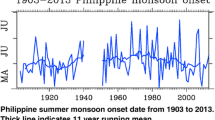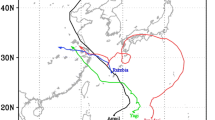Abstract
La Niña conditions during boreal winter sometimes brings excessive snowfall in Japan, especially on the East Sea/Sea of Japan coastal and mountain areas through intensified northwesterly cold winds caused by La-Niña related atmospheric teleconnection. Meanwhile, snowfall events also increase in the Pacific coast area of Japan during the El Niño state due to extratropical cyclones passing along the south coast of Japan (hereafter referred to as South-coast cyclone). In the present study, we investigated year-to-year snowfall/rainfall variations based on meteorological station data and cyclone tracks identified by using the Japanese 55-year Reanalysis. The result clearly indicates increase of the South-coast cyclone during El Niño-developing winters, which is consistent with excessive snow-fall in the northern part of the Pacific coast. Strong subtropical jet hampers cyclogenesis due to less vertical interaction through the trapping of upper-level eddies. During El Niño-developing winters, the subtropical jet is weakened over East Asia, indicating dynamic linkage to increased cyclone frequency. In addition to this, both the deepening of the upper-tropospheric trough over East Asia and anomalous low-tropospheric northwest anticyclones extending from the Philippines toward Japan are also consistent with the enhancement of cyclogenesis over the East China Sea as well as warm winter in Japan.
Similar content being viewed by others
References
Chang, C.-P., and K. M. W. Lau, 1980: Northeasterly cold surges and nearequatorial disturbances over the Winter MONEX area during December 1974. Part II: Planetary-scale aspects. Mon. Wea. Rev., 108, 298–312, doi:10.1175/1520-0493(1980)108<0298:NCSANE>2.0.CO;2.
Chang, E. K. M., S. Lee, and K. L. Swanson, 2002: Storm track dynamics. J. Climate, 15, 2163–2183, doi:10.1175/1520-0442(2002)015<02163: STD>2.0.CO;2.
Endo, H., A. Kitoh, T. Ose, R. Mizuta, and S. Kusunoki, 2012: Future changes and uncertainties in Asian precipitation simulated by multiphysics and multi-sea surface temperature ensemble experiments with high-resolution Meteorological Research Institute atmospheric general circulation models (MRI-AGCMs). J. Geophys. Res., 117, D16118, doi:10.1029/2012JD017874.
Gill, A. E., 1980: Some simple solutions for heat-induced tropical circulation. Quart. J. Roy. Meteor. Soc., 106, 447–462, doi:10.1002/qj.49710644905.
Gong, H., L. Wang, W. Chen, R. Wu, K. Wei, and X. Cui, 2014: The climatology and interannual variability of the East Asian winter monsoon in CMIP5 models. J. Climate, 27, 1659–1678, doi:10.1175/JCLI-D-13-00039.1.
Hayasaki, M., and R. Kawamura, 2012: Cyclone activities in heavy rainfall episodes in Japan during spring season. Sci. Online Lett. Atmos., 8, 45–48, doi:10.2151/sola.2012-012.
Hayasaki, M., R. Kawamura, M. Mori, and M. Watanabe, 2013: Response of extratropical cyclone activity to the Kuroshio meander in northern winter. Geophys. Res. Lett., 40, doi:10.1002/grl.50546.
Kawamura, R., and T. Ogasawara, 2007: Characteristics of large-scale atmospheric circulations associated with the heavy winter snowfall of 2005/06. J. Japanese Soc. Snow Ice, 69, 21–29, doi:10.5331/seppyo.69.21 (in Japanese with English abstract).
Kobayashi, S., and Coauthors, 2015: The JRA-55 reanalysis: General specifications and basic characteristics. J. Meteor. Soc. Japan, 93, 5–48, doi:10.2151/jmsj.2015-001 (in Japanese).
Lee, S.-S., J.-Y. Lee, B. Wang, F.-F. Jin, W.-J. Lee, and K.-J. Ha, 2011: A comparison of climatological subseasonal variations in the wintertime storm track activity between the North Pacific and Atlantic: Local energetics and moisture effect. Climate Dyn., 37, 2455–2469, doi:10. 1007/s00382-011-1027-z.
Manabe, S., 1957: On the modification of air-mass over the Japan Sea when the outburst of cold air predominates. J. Meteor. Soc. Japan, 35, 311–326, doi:10.2151/jmsj1923.35.6_311 (in Japanese).
Mantua, N. J., S. R. Hare, Y. Zhang, J. M. Wallace, and R. C. Francis, 1997: A Pacific interdecadal climate oscillation with impacts on salmon production. Bull. Amer. Meteor. Soc., 78, 1069–1079, doi:10.1175/1520-0477(1997)078.
Matsuno, T., 1966: Quasi-geostrophic motions in the equatorial area. J. Meteor. Soc. Japan, 44, 25–43, doi:10.2151/jmsj1965.70.1B_257 (in Japanese).
Matsumoto, J., 1992: The seasonal changes in Asian and Australian monsoon regions. J. Meteor. Soc. Japan, 70, 257–273, doi:10.2151/jmsj1965.70.1B_257 (in Japanese).
Mizuta, R., M. Matsueda, H. Endo, and S. Yukimoto, 2011: Future change in extratropical cyclones associated with change in the upper troposphere. J. Climate, 24, 6456–6470, doi:10.1175/2011JCLI3969.1.
Nakamura, H., 1992: Midwinter suppression of baloclinic wave activity in the Pacific. J. Atmos. Sci., 49, 1629–1642, doi:10.1175/1520-0469 (1992)049<1629:MSOBWA>2.0.CO;2.
Nakamura, H., and T. Sampe, 2002: Trapping of synoptic-scale disturbances into the North-Pacific subtropical jet core in midwinter. Geophys. Res. Lett., 29, doi:10.1029/2002GL015535.
Nakamura, H., A. Nishina, and S. Minobe, 2012: Response of storm tracks to bimodal Kuroshio path states south of Japan. J. Climate, 25, 7772–7779, doi:10.1175/JCLI-D-12-00326.1.
Nan, S., and P. Zhao, 2012: Snowfall over central-eastern China and Asian atmospheric cold source in January. Int. J. Climatol., 32, 888–899, doi:10.1002/joc.2318.
Ropelewski, C. F., and M. S. Halpert, 1987: Global and regional scale precipitation patterns associated with the El Niño/Southern Oscillation. Mon. Wea. Rev., 115, 1606–1626, doi:10.1175/1520-0493(1987)115 <1606:GARSPP>2.0.CO;2.
Serreze, M. C., J. E. Box, R. G. Barry, and J. E. Walsh, 1993: Characteristics of Arctic synoptic activity, 1952-1989. Meteor. Atmos. Phys., 51, 147–164, doi:10.1007/BF01030491.
Straus, D. M., and J. Shukla, 1997: Variations of midlatitude transient dynamics associated with ENSO. J. Atmos. Sci., 54, 777–790, doi: 10.1175/1520-0469(1997)054<0777:VOMTDA>2.0.CO;2.
Tachibana, Y., T. Nakamura, and N. Tazou, 2007: Interannual variation in snow-accumulation events in Tokyo and its relationship to the Eurasian pattern. Sci. Online Lett. Atmos., 3, 129–132, doi:10.2151/sola.2007-033.
Takayabu, I., 1991: “Coupling Development”: An efficient mechanism for the development of extratropical cyclones. J. Meteor. Soc. Japan, 69, 609–628, doi:10.2151/jmsj1965.69.6_609.
Trenberth, K. E., and J. W. Hurrell, 1994: Decadal atmosphere-ocean variations in the Pacific. Climate Dyn., 9, 303–319, doi:10.1007/BF00204745.
Ueda, H., A. Kibe, M. Saitoh, and T. Inoue, 2015: Snowfall variations in Japan and its linkage with tropical forcing. Int. J. Climatol., 35, 991–998, doi:10.1002/joc.4032.
Ueno, K., 1993: Inter-annual variability of surface cyclone tracks, atmospheric circulation patterns, and precipitation patterns, in winter. J. Meteor. Soc. Japan, 71, 655–671, doi:10.2151/jmsj1965.71.6_655 (in Japanese).
Wang, B., R. Wu, and X. Fu, 2000: Pacific-East Asian teleconnection: How does ENSO affect East Asian climate? J. Climate, 13, 1517–1536, doi:10.1175/1520-0442(2000)013<1517:PEATHD>2.0.CO;2.
Wang, B., Z. Wu, C.-P. Chang, J. Liu, J. Li, and T. Zhou, 2010: Another look at interannual-to-interdecadal variations of the East Asian winter monsoon: the Northern and Southern temperature modes. J. Climate, 23, 1495–1512, doi:10.1175/2009JCLI3243.1.
Wolter, K., and M. S. Timlin, 2011: El Niño/Southern Oscillation behaviour since 1871 as diagnosed in an extended multivariate ENSO index (MEI.ext). Int. J. Climatol., 31, 1074–1087, doi:10.1002/joc.2336.
Wu, B., and J. Wang, 2002: Winter Arctic Oscillation, Siberian High, the East Asian winter monsoon. Geophys. Res. Lett., 29, 1897, doi:10.1029/2002GL015373.
Xie, S.-P., Y. Kosaka, Y. Du, K. Hu, J. S. Chowdary, and G. Huang, 2016: Indo-Western Pacific Ocean capacitor and coherent climate anomalies in post-ENSO summer: A Review. Adv. Atmos. Sci., 33, 411–432, doi:10.1007/s00376-015-5192-6.
Yamazaki, A., M. Honda, and A. Kuwano-Yoshida, 2015: Heavy snowfall in Kanto and on the Pacific Ocean side of northern Japan associated with western Pacific blocking. Sci. Online Lett. Atmos., 11, 59–64, doi:10.2151/sola.2015-013.
Yun, K.-S., Y.-W. Seo, K.-J. Ha, J.-Y. Lee, and Y. Kajikawa, 2014: Interdecadal changes in the Asian winter monsoon variability and its relationship with ENSO and AO. Asia-Pac. J. Atmos. Sci., 50, 531–540, doi:10.1007/s13143-014-0042-5.
Zhang, Y., K. R. Sperber, and J. S. Boyle, 1997: Climatology and interdecadal variation of the East Asian winter monsoon: Results from the 1979-95 NCEP/NCAR Reanalysis. Mon. Wea. Rev., 125, 2605–2619, doi:10.1175/1520-0493(1997)125<2605:CAIVOT>2.0.CO;2.
Author information
Authors and Affiliations
Corresponding author
Rights and permissions
About this article
Cite this article
Ueda, H., Amagai, Y. & Hayasaki, M. South-coast cyclone in Japan during El Niño-caused warm winters. Asia-Pacific J Atmos Sci 53, 287–293 (2017). https://doi.org/10.1007/s13143-017-0025-4
Received:
Accepted:
Published:
Issue Date:
DOI: https://doi.org/10.1007/s13143-017-0025-4




